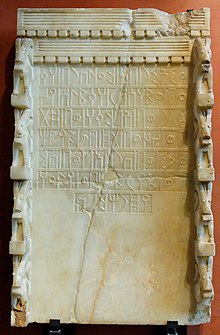אלמקה

אלמקה או אלמוקה (בשבאית: 𐩱𐩡𐩣𐩤𐩠; בערבית: المقه) היה אל הירח של הממלכה התימנית העתיקה סבא. סגדו לו גם בממלכת דעמת וקיסרות אקסום באריתריאה וצפון אתיופיה.
Jacques Ryckmans states,
Almaqah is considered a moon god, but Garbini and Pirenne have shown that the bull's head and the vine motif associated with him may have solar and dionysiac attributes. He was therefore a priest of Ra, the male counterpart of the sun goddess Shamash / Ishtar / Isis, who was also venerated in Saba, but as a tutelary goddess of the royal Egyptian dynasty.[1][2][3]
השושלת השלטת של סבא ראתה את עצמה כזרעו של האל. אלמקה מיוצג באנדרטאות על ידי צרור של ברקים המקיפים נשק מעוגל דמוי מגל. שוורים היו קדושים עבורו.
מקדשיו[עריכת קוד מקור | עריכה]
גם מקדש בראן וגם מקדש אוואם נועדו לאלמקה.
קישורים חיצוניים[עריכת קוד מקור | עריכה]
הערות שוליים[עריכת קוד מקור | עריכה]
- ^ Ryckmans, Jacques (1992). "South Arabia, Religion of". In Freedman, D.N. (ed.). The Anchor Bible Dictionary. Vol. 6. p. 172.
- ^ Ryckmans, Jacques (1989). "Le Panthéon de l'Arabie du Sud préIslamique: Etat des problèmes et brève synthèse". Revue de L'Histoire des Religions. 206 (2): 163.
- ^ For similar comments also see Ryckmans, Jacques (c. 1987). "The Old South Arabian Religion". In Daum, W. (ed.). Yemen: 3000 Years of Art and Civilization in Arabia Felix. p. 107.
